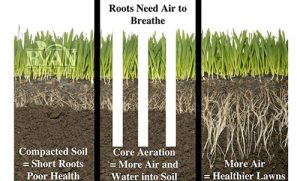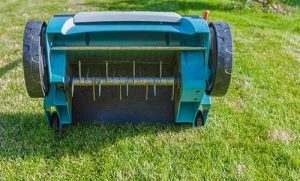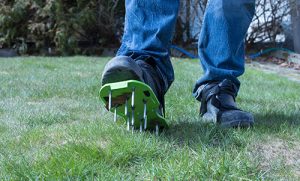What is Lawn Aeration and Why is it Important?
Maintaining a healthy and bright lawn can take significant time and effort. Aside from the regular lawn mowing, fertilizing, and watering, you also need to consider lawn aeration. Not sure what lawn aeration is or why you would ever need to aerate your yard? Don’t Worry.
We’re going to discuss all things related to lawn aeration. We’ll cover everything from what is lawn aeration, when to aerate my lawn, how to lawn aerate, to what tools you should use for your DIY lawn aeration.
Why Lawn Aeration is Important
 You might be thinking ‘Why do I need to aerate my yard?’ Well, just like human beings, lawns need to breathe. Lawn aeration refers to any technique used to increase airflow in your lawn and the soil underneath it. Increasing the flow of oxygen by poking holes strategically across the surface of your lawn allows stale carbon dioxide to leave.
You might be thinking ‘Why do I need to aerate my yard?’ Well, just like human beings, lawns need to breathe. Lawn aeration refers to any technique used to increase airflow in your lawn and the soil underneath it. Increasing the flow of oxygen by poking holes strategically across the surface of your lawn allows stale carbon dioxide to leave.
The fresh oxygen flowing through the layers of the soil improves grassroots water consumption. It also allows the nutrients to move more freely through the soil promoting better and more evenly distributed nutrient consumption.
Aerating your lawn also helps to break down built-up thatch which reduces lawn compaction – the main cause of moss.
Signs You Need to Aerate Your Lawn
Timing your lawn aeration correctly is the key to success. In general, you should aerate your lawn when it is at its peak growing period. This allows it to quickly recover from the ‘stress’ brought on by the lawn aeration process. For midwestern grasses such as Kentucky Bluegrass, early fall and spring are generally the best times.
Aside from seasonal timing, there are a few common tell-tale signs that it might be time for you to aerate your yard. Keeping a close eye on the following signs in your grass will give you a clear idea of whether your grass has become overly compact and is in need of aeration.
1. Puddles
Puddles are a sign that your soil has become too compact to allow water to flow down to lower layers. This poses several threats, including not allowing grassroots access to new nutrients and providing a breeding ground for mosquitoes.
2. Worn Areas
Worn areas appear patchy and dull compared to the brighter greener areas. This could be an indication that you should plant a few more grass seeds across your lawn and aerate to allow growth.
3. Insufficient Moisture Absorption
Insufficient absorption of moisture occurs when the soil has become too compact. This is different from water not absorbing due to saturation which remains wet for some time. Compacted soil doesn’t stay wet or moist for long.
4. Thin and Dull
Soil compaction is usually also responsible for causing the grass to thin and bald. Your grass might start to thin and dull because the grass roots are not getting enough nutrients at the bottom, causing the grass to die at the top.
5. Lack of Growth
When your lawn stops growing altogether, even during its peak growing season, it’s time to give it some love. Again, this lack of growth is generally a sign of soil compaction of low nutrient density. Proving nutrients and poking holes to aerate your lawn should help the grass start growing again.
6. The Screwdriver Test
The screwdriver test involves simply poking a screwdriver down into your soil. If it moves through the soil with ease, it’s probably not in need of immediate aeration. However, if you experience a great deal of difficulty trying to push the screwdriver into the soil, it could be a sign that it has become too compact.
Aeration Tools: Spike Lawn Aerator or Plug Aerator

Here are the two most commonly used lawn aeration tools with some useful information regarding their build and usage.
Spike Lawn Aerator
A spike aerator has sharp, thin spikes which penetrate the ground. They do not remove any soil matter. The spikes end up increasing soil compaction because each spike causes the soil to move and forces the soil into a more dense mass.. You can get spike aerators in the form of mower wheels, spiked shoes, and hand and foot manual spike aerators.
When to Use
Spike aerators are generally used on smaller surface areas where the compaction is not too severe. Soils with a heavy clay content often become impacted, which restricts the ability of the grass roots to receive oxygen.
Plug Aerator
Plug aerators have a wide, hollow core that plugs into the grass and removes a chunk of soil. They go deeper than spike aerators, and by removing soil, they allow for more comprehensive lawn aeration.
When to Use
These are more suitable for medium to larger lawns that are suffering from severe compaction. With more severe soil compaction simply piercing the soil with thin spikes is superficial and does not provide long-term relief for the soil.
How to Aerate Your Lawn
It’s best to aerate your lawn when the soil is as moist as it can possibly be. Aerating your lawn after it has rained is a great way to ensure optimum moisture.
Tools like the spike aerator will only pierce a few holes at a time, so passing over your lawn multiple times with your tool of choice is key for successful aeration.
After you’ve aerated your lawn, be sure to apply some fertilizer. This will provide extra nutrition which can now move more freely to the grassroots. Applying fertilizer also promotes thick, bright green grass growth.
When to Aerate Your Yard in the Midwest
Some of the most common types of grass found on lawns in the Midwest include Kentucky Bluegrass, Fine Fescue, and Perennial Ryegrass.
Aeration and overseeding for these grass types should be done in the spring or fall. This is because these are when the grass is growing at the fastest rate. Any damage or trauma caused by the aeration process can be quickly healed during these times.
Spring aeration should generally be done between March and May, and fall aeration should be done around late August or early September.
DIY Lawn Aeration or Hire the Professionals

Maintaining a healthy lawn takes time and patience, but the results are very rewarding. Paying attention to a few tell-tale signs will help you identify whether it’s time to get out your aeration tools or hire your local lawn aeration company.
Do You Need Some Professional Help Aerating Your Lawn?
We would love to help you. Get a Free Estimate today for help with your lawn aeration needs by a RYAN lawn care expert!









